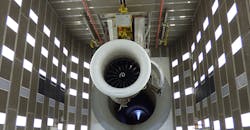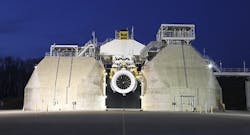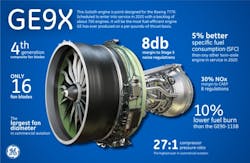This secretive base hidden in the outskirts of Appalachia, with its curvy terrain covered in thick deciduous forests and snaked with fuel pipes leading to massive concrete bunkers, is the type of place the Empire would hide a Death Star’s force field generator.
But this is Ohio, not a moon of Endor, so the portly, furry inhabitants here are beavers, not Ewoks, and the bleeding edge engines assembled and tested here will end up powering Boeing’s newest commercial airliners, not Imperial Star Destroyers.
General Electric has used this 6,700-acre expanse called the Peebles Test Operation—located an hour east of GE Aviation’s Cincinnati headquarters—since the 1950s, first as a rocket testing site, then for military and commercial aircraft engines.
Its isolated position has buffered it from prying eyes and, more importantly for neighbors, from the thunderous scream of the 1,800 jets engines tested here every year to meet FAA and European Aviation Safety Agency requirements.
At its unassuming 6,700-acre Peebles Test Operation in the foothills of Southern Ohio, GE is developing the world's most sophisticated commercial jet engines.
Photo: GE Aviation
Prior to sending an engine to the airframer, Peebles runs a “break-in” test, running the engine through take-off, climb, cruise, and landing. For the larger engines, Peebles has two massive indoor testing spaces connected to control rooms with big screens, flashing buttons, and shiny levers. The near empty rooms themselves are about 40 ft. high, with one wall just a giant computer screen and another has a giant black hole leading to an exhaust stack, about the size of the 111-in. wide engine hanging in front of it. The engine sucks the air through the screen and funnels it into the fan, with the exhaust going into the stack. The auto coupling plate, the wired harness the engine hangs from, funnels all the sensor data to the control room for analysis. This is what it’s really all about there.
During testing, continuous data from this production GEnx jet engine is fed to the control room to detect any anomalies. It also looks like the inside of the Death Star.
Photo: John Hitch
“Getting the data and getting the data analysis has been the biggest key,” explains Deborah Case, GE Aviation media relations representative and occasional Peebles tour guide.
This is true in terms of ensuring each jet engine is ready for takeoff, and in GE’s strategy to provide industrial companies the world over with a new method to harness the important big data that could otherwise be lost in the wind. The crux to this plan is Predix, the Industrial Internet platform that represents GE’s new hope to digitally terraform the world into brilliant, efficient place.
“It’s almost like remote diagnostics on steroids,” explains Case of the Predix Platform as a Service(PaaS), which has been used by GE internally for four years. GE Aviation and Peebles had a big part in its genesis, but Predix has now flown the nest to start managing the rest of GE’s $1 trillion in assets.
The big news now is that it’s available to third-party developers.
This is what upgrades it from Internet of Things to Internet of Important Things. Dunsdon says these third-party software developers are given a “contextually relevant” API to clean up data and detect anomalies, with a strong foundation already laid by the conglomerate, “so you don’t need to code those up.”
This means all that much of that lost 97% can be turned into meaningful values, so engineers aren’t left to work with the raw data of ones and zeroes, Dunsdon explains.
There is about one terabyte of data accrued during a flight. Six years ago, jet engine data was in the realm of 3.2 Kb for each takeoff, climb, or cruise message, Dunsdon says.
The diagnostics test at Peebles simulates this as closely as possible while staying earthbound. The four-hour acceptance test for the GE90-115B, which boasts a world leading 115,000-lbf thrust rating, uses 10,000 gal. of real jet fuel. The 11 indoor and outdoor test sites consume 10 million gal. annually, explaining all those pipes cutting through the hillsides.
All that fuel isn’t going to waste, as all that data informs the engineers on how to innovate the next big thing. In fact, the 35,000 engines GE Aviation has under management are feeding data back to GE’s brain. How to manage that data is what brought to Predix to life.
“[Aviation] is a particularly challenging use case, because events are much rarer than any other industry, except possibly nuclear,” says Dunsdon. “We build our equipment to such a high standard that the level of analytics we need to detect failure is quite exceptional.”
Going back to the Star Wars reference, you can think of Predix as a cloud-based version of the Force (algorithm-based; no midi-chlorians here). It can be in all Industrial Internet of Things, giving a user a foresight with trend detection capabilities, and warns of “disturbances in the force” with anomaly detection.
For an aircraft engine, it will prognosticate the effectiveness of a water wash based on every variable imaginable. A sandier region, say Dubai, may require more frequent maintenance than in France. Predix can lay this out for the airline, along with how that maintenance time will affect other flight plans.
“Predix is now helping airlines look at what is the impact of delaying or canceling a flight,” Dunsdon says. “There are days airlines have no choice. Predix tells the airline, ‘This is the least painful flight for you to cancel and this is the impact in passenger disruption and delays.’”
A 2010 FAA-funded study by the University of California, Berkeley, found that the cost of flight delays is $32.9 billion, half of that cost picked up by passengers.
An airline using predictive software to mitigate these delays could theoretically offer lower fares than those that don’t.
“As a passenger, I’m excited because hopefully I’ll get delayed less,” Dunsdon says.
Airlines using Predix software can prepare for and respond to previously unpredictable engine downtime, preventing massive flight disruption.
Image: GE
GE makes a big deal that Predix’s combination of operational and historical analytics will allow any industry to increase performance by 1%.
This includes healthcare, oil and gas, power generation, and transportation.
“If you get freight to move 1%, that makes a huge difference CO2 emissions,” Dunsdon says. “What I see beyond aviation is to help make industrial equipment more effective.”
GE expects Predix to be the Apple iOS of industry.
“Apple said, ‘Look, we’ll build the environment, we’ll provide some fantastic examples of the types of apps you can deploy, but we’re not going to be able to build all the right ones,’” says Dunsdon, who believes GE is taking a similar tactic. “We’ll deal with the platform side and how to get the data together; you bring your nugget of brilliance and build that overall ecosystem.”
In one of the wooded nooks at Peebles, suspended from a test stand in a cleared corridor—the 120,000-lb GE9X, which at 134 in. in diameter is the world’s largest turbofan engine —waits patiently for its turn to run the brutal gamut of developmental tests.
The ultra quiet, super efficient GE9X turbofan engine is the largest of its kind, and is expected to be in service on the Boeing 777X by 2020.
Photo: GE Aviation
It’s more like a firing line, as several ingeniously engineered pneumatic cannons will someday barrage the engine with simulated torrential rain, hailstones, ice sheets, and even duck corpses. Before going into production, the Peebles engineers will even perform the “blade out” test on another unlucky GE9X; meaning the engineers will attach a charge to the interior of the fan casing and blow it up, to ensure the housing will contain and funnel the materials back in the event of an explosion, not into the fuselage.
No one is blowing up this baby just yet. All those tests are years away; the engine isn’t expected to enter service until 2020. It was only in March that the crew successfully started up the GE9X for the first time, just six months after the $25 million engine design was finalized. Seven hundred of the engines have already been ordered to power the new Boeing 777X airliners.
“We’ve had a busy last decade,” Case says. “The 9X is the top of the mountain for us. It has all our newest technologies in it, everything our teams have been working on.”
To have everything America’s oldest research lab, an offshoot of Thomas Edison’s mythical lab at Menlo Park, may be a bit hyperbole, but it does highlight the electric empire’s divisions’ ability to march lockstep with each other.
The drumbeat now is calling for brains over brawn. Leveraging the lessons learned and data collected since GE started mass producing the first jet engines in 1942, the GE9X simply does more with less.
Most visibly apparent are the 16 fourth-generation carbon fiber composite fan blades, instead of the 22 found on the GEnx and GE90. The fan case is also made of composite materials. These are about one-third the weight of metals, resulting in about a 400-lb reduction in weight.
Overall it has fewer parts, one reason being the fuel nozzle, which is now 3D printed. It burns less fuel, equaling about a 10% increase in fuel efficiency over the GE90, due in part to a revolutionary ceramic matric composite in the combustor, silicon carbide.
“Silicon carbide can withstand much higher temperatures than any high- strength engine we can make a jet engine out of,” explains Todd Wetzel, GE’s lead thermal systems technology leader. “That means we can run the engine hotter, which makes it more fuel efficient. It also means we don’t need to use as much coolant to protect it, which also makes it efficient.”
The CMC material was first used on the CFM LEAP engine, a collaboration between GE and Snecma of France, that will go into service in 2017 and offers a 15% increase in efficiency over the previous version. Further increasing the efficiency is the 11-stage compressor that results in a 27:1 compressor pressure ratio, GE’s highest for a commercial engine.
This efficiency will only increase as Predix absorbs the GE9X’s flight data and plugs it into its “digital twin.”
“It’s a living model that changes as the machine changes, as the data tells us different things about the operating system,” says Todd Alhart, communications manager for GE Global Research. “We also can look at the data of all our jet engines to provide additional insights on any one engine.”
GE's wind turbines also have a cloud-based digital twin that changes throughout the real turbine's life.
Image: GE
Using a producibility advisor tool, GE can tell if a part is producible before it’s physically manufactured in the factory.
“When you design a part, you run it through this adviser, and it will tell you if it’s producible,” Alhart says. “And if it’s not, it will tell you where you violated a given design rule. We also have software that figures out how much it will cost to make and we can virtually design a manufacturing process before we even tap into a material or turn on machine.”
If the Empire in a galaxy far, far away had this feature, the 2-m wide thermal exhaust port leading to the Death Star’s reactor probably would have been redesigned.
It’s a good thing GE’s most notable accomplishment was bringing light to the world. Predix hasn’t been around long enough to judge its impact, or if it will really create the Brilliant Factories GE envisions. Like the Force, it is merely a tool to help you understand your environment better. Maybe it will empower some conglomerate to more efficiently cut down the rain forests, or maybe it will be used to solve world hunger. No one knows.
One thing is for certain: we can’t predict how Predix will change the world; it will make it easier to affect change on the world, even if it’s 1%.
“By GE opening things up, you create a world in which people can come together and create game changing solutions for industry,” Dunsdon concludes.

















